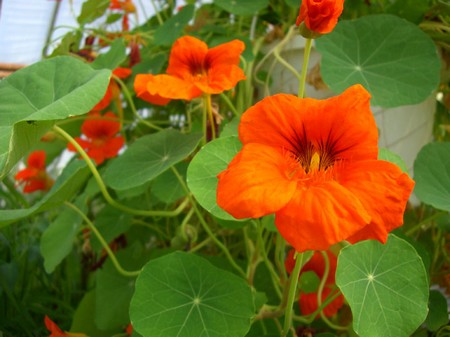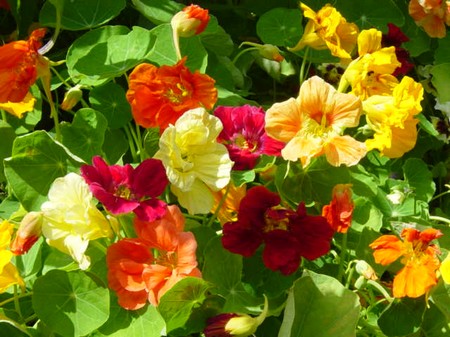This lovely bright and colourful annual is one of the easiest and most rewarding flowers to grow from seed. Nasturtiums come from tropical South America, where they are perennial. They were among the treasures brought back from Peru by the conquistadores along with the gold of the Incas.
In 16th century England it was called ‘blood flower of Peru’, and Indian cress, because of its similarity to watercress (Nasturtium officinale) with its pungent taste and smell. The name nasturtium comes from nasus tortus meaning ‘nose-twisting’ because of its peppery smell. However, the flower was welcomed as a rare treasure in Elizabethan and Stuart England. John Evelyn recommended the seed for scurvy, ‘the most effectual and powerful agents in conquering and expunging that cruel Enemy.’ In one story the nasturtium is said to have arisen from the spilled blood of a Trojan warrior, the round leaves being his shield and the trumpet-shaped flower his helmet. The name Tropaeolum comes from the Greek tropaion, meaning trophy. In the language of flowers the nasturtium symbolizes patriotism.
All parts of the plant are edible and nutritious, being rich in iron, vitamin C, minerals and trace elements. The unripe seeds make a substitute for capers, while the flowers can be mixed in salads. The leaves add piquancy to soups, salads and sandwiches.
Herbal remedy
Like watercress, nasturtium is both pungent and bitter, making it a good blood cleanser, aiding the body’s elimination of toxins. The pungency is warming and stimulating. It invigorates the digestion, improving appetite and absorption of its nutritious contents. It acts as a tonic for weak digestion and food stagnation which lead to toxicity and poor absorption. It increases the circulation, carrying the absorbed nutrients around the body to where they are needed, giving a sense of wellbeing and strength. The bitters are also detoxifying, stimulating the liver, pancreas and gall-bladder activity and the secretion of digestive enzymes. The bitters in the seeds stimulate the bowels and ensure elimination of toxins via this route. Nasturtium acts on the kidneys and bladder, increasing elimination of waste products in the urine.
Nasturtium also has antimicrobial properties. It is used particularly for chest infections, and because it also has decongestant properties it is well worth using to clear the phlegm that accompanies bronchial problems. The fresh juice or an infusion of the leaves relieves colds, catarrh, and chronic bronchial congestion. Its high vitamin C content is useful here. It can also be taken for urinary tract infections such as cystitis. As a natural antibiotic it will not destroy the normal bacterial population of the intestines.
The combination of its nourishing, detoxifying and immune-enhancing properties makes nasturtium a good tonic for those feeling depleted and run down. Being high in iron it is helpful when feeling tired because of anaemia. Its strengthening effect was used in the past as a rejuvenative and an aphrodisiac, hence its names passionflower, and flower of love.
Externally, nasturtium has an old reputation of retarding balding. The tincture of nasturtium leaves, oak bark and nettles was massaged regularly into the scalp — so nasturtium helps ‘keep your hair on’.
Homeopathic remedy: Nasturtium
Nasturtium is used for urinary problems, including infections such as cystitis, stones and gravel.
The flower essence
Nasturtium, like the herbal remedy, is warming, rejuvenating, refreshing and revitalizing. It is particularly recommended for those who feel drained from excess mental activity, such as students and those whose careers demand concentrated intellectual work. Such people may become over-developed mentally and live too much in the head, lacking physical or emotional expression, and divorced from many of the realities of daily life. Such imbalance may predispose to illness, immune dysfunction, coughs, colds and catarrh.
Nasturtium brings balance between intellectual, emotional and physical activity. It restores emotional warmth, physical vitality and earthly practicality.

